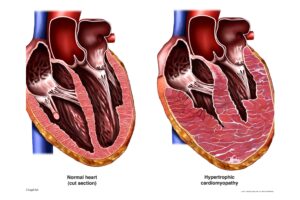
Hypertrophic cardiomyopathy. The image above shows a healthy heart and a heart muscle that is larger and thicker because of hypertrophic cardiomyopathy. Medical Illustration Copyright ©️ 2022 Nucleus Medical Media, All rights reserved
MINNEAPOLIS — The typical hypertrophic cardiomyopathy patient appears to have changed somewhat, according to a new study, which pointed out that “clinicians are encountering a phenotype of hypertrophic cardiomyopathy evolving from the disease recognized several years ago.”
A study led by the Hypertrophic Cardiomyopathy Center at the Minneapolis Heart Institute Foundation followed 3,161 consecutive patients with established hypertrophic cardiomyopathy from 2003-2020. The patients were studied clinically and with imaging.
The article in the American Journal of Medicine noted that patients were identified as progressively older now (average 56 ± 15 years) compared to 44 ± 17 years previously (p<0.001). Researchers observed that they also had an increasing frequency of outflow obstruction (from 46% to 61% of patients; p<0.001), although without more advanced heart failure symptoms.1
“Notably, maximum left ventricular wall thickness (usually ventricular septum) decreased progressively over the same period (20.4 ± 5.7 to 17.5 ± 3.4 mm),” the authors wrote.
“These novel observations are counter-initiative to practitioners expecting hypertrophic cardiomyopathy to be associated with particularly substantial hypertrophy, and potentially impact disease recognition, while also highlighting emergence of symptomatic obstructive patients with septal thickness <15 mm, requiring modification of traditional myectomy operation,” according to the report. “While a primary change in phenotypic expression of hypertrophic cardiomyopathy cannot be excluded by our data, these observations most likely reflect evolving referral practice patterns including such greater diagnostic suspicion for the disease in the community particularly at advanced ages and/or with less substantial left ventricular hypertrophy.”
A study from the George E. Wahlen Department of VAMC in Salt Lake City four years ago also noted some alterations in the hypertrophic cardiomyopathy population at the VA. Their report was on the organ allocation policy at the nation’s largest healthcare system, and they discussed how patients with left ventricular assist devices were favored for heart transplants.
The authors pointed out in the journal Circulation: Heart Failure, how heart transplant “candidates with hypertrophic cardiomyopathy (HCM) are usually not left ventricular assist device candidates and may have a disadvantage compared with dilated forms of cardiomyopathy.”2
The study included other important information, including that the proportion of patients with HCM listed for HT increased by 44% from the beginning of a time period from 1999 and 2016 to the end. At the same time, a minimal decline in mortality was observed in HCM patients (11.7%-9.6%; P=0.06). Yet, post-transplant survival in HCM patients was the most favorable in recent years (1 year: 91.6% and 5 years: 82.5%;P<0.05 for all comparisons).
“The number of patients with HCM in need of HT is increasing,” the authors advised. “Although post-transplant survival in HCM is excellent, waitlist mortality is substantial and with minimal decline in the most recent era, despite the frequent use of listing status upgrade by exception in this patient cohort. Different strategies to improve the performance of the organ allocation system in patients with HCM are needed.”
- Maron BJ, Rowin EJ, Ambe SP, Maron MS. Changing Demographics in Hypertrophic Cardiomyopathy and Implications for Management: Clinical Research. Am J Med. 2022 May 29:S0002-9343(22)00390-4. doi: 10.1016/j.amjmed.2022.05.006. Epub ahead of print. PMID: 35649468.
- Zuñiga Cisneros J, Stehlik J, Selzman CH, Drakos SG, McKellar SH, Wever-Pinzon O. Outcomes in Patients With Hypertrophic Cardiomyopathy Awaiting Heart Transplantation. Circ Heart Fail. 2018 Mar;11(3):e004378. doi: 10.1161/CIRCHEARTFAILURE.117.004378. PMID: 29664404.


